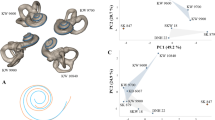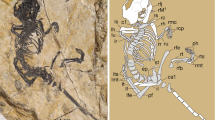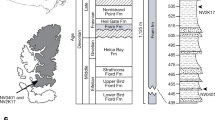Abstract
The Late Devonian genus Ichthyostega was for many decades the earliest known tetrapod, and the sole representative of a transitional form between a fish and a land vertebrate. However, despite being known since 1932 (ref. 1) from a large collection of specimens, its morphology remained enigmatic and not what was expected of a very primitive tetrapod2. Its apparent specializations led it to be considered as a “blind offshoot”3 or “sidebranch”4 off the tetrapod family tree, and recent cladistic analyses have disagreed about its exact phylogenetic position5,6,7,8 within the tetrapod stem group. In particular, its braincase and ear region defied interpretation, such that conventional anatomical terms seemed inapplicable4. Using new material collected in 1998 (ref. 9), preparation of earlier-collected material, and high-resolution computed tomography scanning, here we identify and interpret these problematic anatomical structures. They can now be seen to form part of a highly specialized ear, probably a hearing device for use in water. This represents a structurally and functionally unique modification of the tetrapod otic region, unlike anything seen in subsequent tetrapod evolution. The presence of deeply grooved gill bars as in its contemporary Acanthostega10 suggest that Ichthyostega may have been more aquatically adapted than previously believed.
This is a preview of subscription content, access via your institution
Access options
Subscribe to this journal
Receive 51 print issues and online access
$199.00 per year
only $3.90 per issue
Buy this article
- Purchase on Springer Link
- Instant access to full article PDF
Prices may be subject to local taxes which are calculated during checkout




Similar content being viewed by others
References
Säve-Söderbergh, G. Preliminary note on Devonian stegocephalians from East Greenland. Meddelelser Grønland 98, 1–211 (1932)
Jarvik, E. On the fish-like tail in the ichthyostegid stegocephalians. Meddelelser Grønland 114, 1–90 (1952)
Jarvik, E. Basic Structure and Evolution of Vertebrates Vol. 1–2 (Academic, New York, 1980)
Jarvik, E. The Devonian tetrapod Ichthyostega. Fossils Strata 40, 1–206 (1996)
Ahlberg, P. E. & Clack, J. A. Lower jaws, lower tetrapods—a review based on the Devonian genus Acanthostega. Trans. R. Soc. Edinb. Earth Sci. 89, 11–46 (1998)
Laurin, M. The importance of global parsimony and historical bias in understanding tetrapod evolution. Part I. Systematics, middle ear evolution and jaw suspension. Annales Sci. Naturelles 1, 1–42 (1998)
Clack, J. A. An early tetrapod from Romer's Gap. Nature 418, 72–76 (2002)
Ruta, M., Coates, M. I. & Quicke, D. L. J. Early tetrapod relationships revisited. Biol. Rev. 481, 251–345 (2003)
Clack, J. A. & Neininger, S. L. in New Perspectives on the Old Red Sandstone (eds Friend, P. F. & Williams, B.) 557–566 (Geological Society Symposium Volume, London, 2000)
Coates, M. I. & Clack, J. A. Fish-like gills and breathing in the earliest known tetrapod. Nature 352, 234–236 (1991)
Ahlberg, P. E., Clack, J. A. & Lukševičs, E. Rapid braincase evolution between Panderichthys and the earliest tetrapods. Nature 381, 61–64 (1996)
Clack, J. A. The neurocranium of Acanthostega gunnari and the evolution of the otic region in tetrapods. Zool. J. Linn. Soc. 122, 61–97 (1998)
Clack, J. A. Pholiderpeton scutigerum Huxley, an amphibian from the Yorkshire coal measures. Phil. Trans. Roy. Soc. Lond. B 318, 1–107 (1987)
Smithson, T. R. The cranial morphology of Greererpeton burkemorani (Amphibia: Temnospondyli). Zool. J. Linn. Soc. 76, 29–90 (1982)
Bernacsek, G. M. & Carroll, R. L. Semicircular canal size in fossil fishes and amphibians. Can. J. Earth Sci. 18, 150–156 (1981)
Clack, J. A. Patterns and processes in the early evolution of the tetrapod ear. J. Neurobiol. 53, 251–264 (2002)
Yan, H. Y., Fine, M. L., Horn, N. S. & Colon, W. E. Variability in the role of the gasbladder in fish audition. J. Comp. Physiol. 186, 435–445 (2000)
Hetherington, T. E. & Lombard, R. E. Biophysics of underwater hearing in anuran amphibians. J. Exp. Biol. 98, 49–66 (1982)
Dominguez, P., Jacobson, A. G. & Jefferies, R. P. S. Paired gill slits in a fossil with a calcite skeleton. Nature 417, 841–844 (2002)
Ketcham, R. A. & Carlson, W. D. Acquisition, optimization and interpretation of X-ray computed tomographic imagery: Applications to the geosciences. Comp. Geosci. 27, 381–400 (2001)
Smithson, T. R. & Thomson, K. S. The hyomandibula of Eusthenopteron foordi Whiteaves (Pisces: Crossopterygii) and the early evolution of the tetrapod stapes. Zool. J. Linn. Soc. 74, 93–103 (1982)
Clack, J. A. The stapes of the Coal Measures embolomere Pholiderpeton scutigerum Huxley (Amphibia: Anthracosauria) and otic evolution in early tetrapods. Zool. J. Linn. Soc. 79, 121–148 (1983)
Acknowledgements
We thank the staff of MGUH and the Demark and Greenland Geological Survey for cooperation, access to material and support in the field; M. Colbert (UTCT) for technical assistance; H. Blom for discussion of the anatomy of Ichthyostega; and NERC and BBSRC for funding the project and additional CT scanning.
Author information
Authors and Affiliations
Corresponding author
Ethics declarations
Competing interests
The authors declare that they have no competing financial interests.
Supplementary information
41586_2003_BFnature01904_MOESM1_ESM.mov
Supplementary Movie: This shows the skull roof with the braincase and stapes in place, rotating about an approximately parasagittal axis. Note the inflated chamber formed under the skull table area and the separation of this chamber from the adductor fossa. (MOV 673 kb)
41586_2003_BFnature01904_MOESM4_ESM.mov
Supplementary Movie: This shows the lateral view of the braincase with the stapes in place, roofing bones and palatoquadrate ossifications removed, rotating about a horizontalplane. (MOV 624 kb)
41586_2003_BFnature01904_MOESM5_ESM.mov
Supplementary Movie: This shows the braincase and roofing bones with the stapes in place, in lateral view rotating through about 45 degrees along a parasagittal axis. (MOV 659 kb)
Rights and permissions
About this article
Cite this article
Clack, J., Ahlberg, P., Finney, S. et al. A uniquely specialized ear in a very early tetrapod. Nature 425, 65–69 (2003). https://doi.org/10.1038/nature01904
Received:
Accepted:
Issue Date:
DOI: https://doi.org/10.1038/nature01904
This article is cited by
-
Morphology of the earliest reconstructable tetrapod Parmastega aelidae
Nature (2019)
-
Euryhaline ecology of early tetrapods revealed by stable isotopes
Nature (2018)
-
Hidden morphological diversity among early tetrapods
Nature (2017)
-
Comparative Auditory Neuroscience: Understanding the Evolution and Function of Ears
Journal of the Association for Research in Otolaryngology (2017)
-
Comparative and developmental patterns of amphibious auditory function in salamanders
Journal of Comparative Physiology A (2016)
Comments
By submitting a comment you agree to abide by our Terms and Community Guidelines. If you find something abusive or that does not comply with our terms or guidelines please flag it as inappropriate.



